 — Recommendations are independently chosen by Reviewed’s editors. Purchases you make through our links may earn us a commission.
— Recommendations are independently chosen by Reviewed’s editors. Purchases you make through our links may earn us a commission.As the weather outside becomes frightful, your skin may not normally feel delightful. But before you let the freezing temperatures or stale indoor heat get you down, here's the good news: You can easily remedy your cold-weather woes before they start. Thanks to these helpful tips from dermatologists, you can maintain your glow regardless of the forecast.
Related content
1. Moisturize ... and then moisturize more
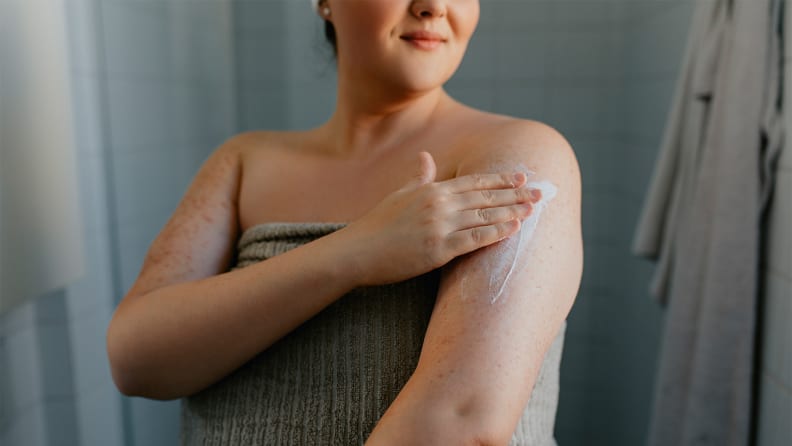
Moisturize both the face and body to keep the skin healthy.
The biggest way to avoid dry, flaky, and chapped skin during the winter is to up the ante on your moisturizing game. While a lightweight formula may be ideal on muggy summer days, a thicker, more hydrating one is best when the temperature drops. Still, it's important to choose products that are right for your skin type that can add lubrication and to protect your skin barrier (the outermost layer of skin), says Dr. Macrene Alexiades, the director and founder of Dermatology and Laser Surgery Center of New York and an associate clinical professor at Yale University School of Medicine.
For those with normal skin (neither oily nor dry), Alexiades recommends a moisturizer with humectants, such as glycerin, lactic acid, and hyaluronic acid, that each attract and hold water molecules in the skin to prevent it from dehydration. One option is the La Roche Posay Double Repair Face Moisturizer, which has a thick, creamy texture. The Neutrogena Hydro-Boost Water Gel also fills the bill and may be better for you if you prefer something light that’ll refresh your skin without feeling too thick.
Alexiades says to aim for more decadent ingredients called occlusives, such as oils or petrolatum, if you have drier or more mature skin. In this case, consider the Cerave Moisturizing Cream with it’s gentle, skin-protecting ingredients such as ceramides and hyaluronic acid. Or try the Skinceuticals Hydra Balm for a skin-soothing experience thanks to pure petrolatum, aloe, and bisabolol.
Lastly, if you have oily skin and are prone to breakouts, you should choose non-comedogenic emollients, like fatty alcohols and cocoa butter, that lock in hydration without causing acne. Alexiades recommends the Olay Regenerist Whip Facial Moisturizer for its skin-smoothing ingredients, including vitamin B3 and hyaluronic acid. Another option is the Skinceuticals Daily Moisture, which is lightweight and has a milky consistency that quenches your pores without clogging them.
2. Consider a humidifier

Add a humidifier to your space to keep the air from getting too dry.
Do you wake up in the morning with chapped lips or suffer from bloody noses in the winter? It could be because of the air in your home. The lack of moisture indoors can cause dry skin, so it’s crucial to balance the water loss with a humidifier, says Dr. Melanie Palm, a board-certified dermatologist at the Art of Skin MD in San Diego. “Those who live in colder climates usually blast their heaters throughout the day, which zaps any little moisture that’s left in the air during the winter,” she says. “Consider investing in a humidifier for your bedroom to boost humidity levels, which can help your skin retain moisture during cold winter months. A diffuser at your workspace or desk can also increase humidity in small spaces.”
After testing humidifiers, our top pick is the Vicks V745A because it can run for about 10 hours and works with medicinal-grade oils to soothe your senses.
3. Don’t skimp on sunscreen
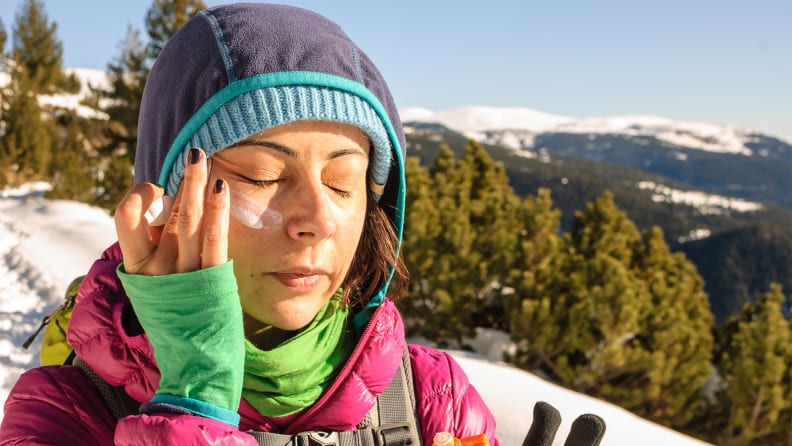
Keep your skin protected all winter long with sunscreen.
As temperatures fall, it’s tempting to think that SPF isn’t needed—but every day requires sunscreen. UV radiation, especially UVA that’s responsible for skin aging, is still present and can reach us in winter months, warns Dr. Papri Sarkar, a board-certified dermatologist in Brookline, Mass. “Exposure can still cause dark spots, DNA damage, wrinkles, and skin cancer,” she continues. “When you’re in the snow all day, you get even more sun, as the ambient sunlight from the sky hits your skin and then reflects off the snow to hit you yet again.”
While Sarkar says that sunscreen application is most essential when you’re skiing or snowboarding, it’s even important for folks who walk outside in snowy weather. An excellent winter SPF option is the Lancôme UV Expert Aquagel Defense 50 Sunscreen, which acts as an oil-free face primer, moisturizer, and SPF all in one.
4. Incorporate a hydrating mask twice a week
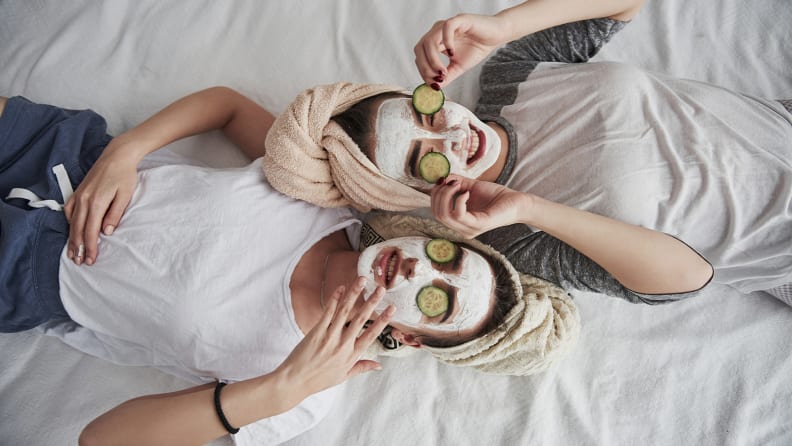
Apply a hydrating mask when your skin needs a boost.
In addition to the skincare routine you typically follow—cleansing, moisturizing, and protecting with sunscreen—Palm says it’s also a good idea to incorporate a hydrating mask twice a week to give your skin the extra moisture it needs. She recommends choosing a product that doesn’t need to be rinsed off and instead just absorbs into your skin. Her top picks are Colorescience’s Total Eye Restore Day & Night Treatment Mask for its inclusion of eye masks, eye concentrate, and tinted eye therapy cream that all moisturize the skin. To keep it simpler and focus on your whole face, go for Avene’s Soothing Radiance Mask, which has gentle ingredients like red fruit extract and thermal water. “Leave the mask on for a half-hour, then slather the remaining moisture down to the neck,” Palm says.
5. Turn down the temperature when cleansing

Use warm water instead of hot to avoid drying out your skin.
When you’re commuting in snowy weather or carrying in groceries, you may look forward to a steamy shower to warm up your bones. However, a scorching-hot rinse can be detrimental for your sensitive winter skin, Alexiades warns. “This is a no-no because hot water heats your skin, which will cool itself down by evaporating its water, leaving it dry and red,” she says.
Instead, Alexiades recommends using warm or lukewarm water to wash your face with a cleanser and then immediately applying moisturizer to lock in hydration. “Your skin result will be hydrated and soothed, resulting in a luminous complexion,” she says. Examples of hydrating cleansers include the Cetaphil Daily Facial Cleanser, which is ideal for those with sensitive skin that breaks out easily. Or try the Albolene Moisturizing Cleanser for a thicker wash that gets rid of grime, but leaves a slightly silky finish, too.
6. Keep lip balm handy
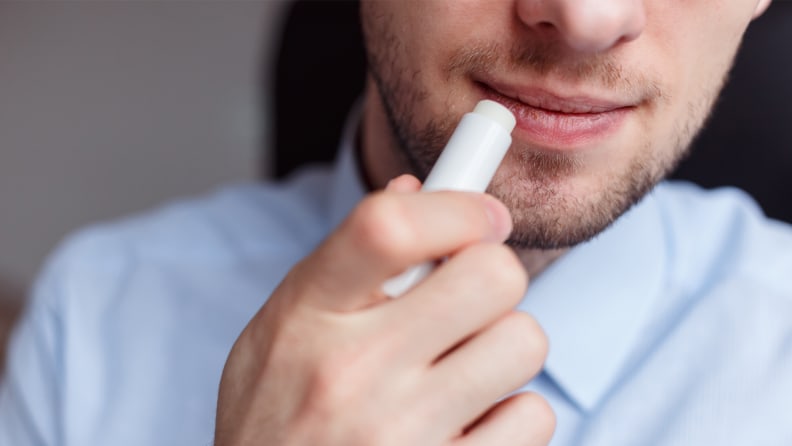
Keep a lip balm on hand to avoid chapped lips.
While you may pay more attention to your cheeks and forehead, there’s another part of your face that needs your attention: your lips. It’s important to keep your pout hydrated all year, but you may notice more chapping in the colder, dryer months, says Dr. Luigi L. Polla, a Geneva-based dermatologist and the founder of the Forever Institut and Alchimie Forever. “The skin of the lips is the thinnest, and as such, it does not provide much protection against the elements,” he says. To the rescue is an occlusive treatment every night, such as the Laneige Lip Sleeping Mask with vitamin C and hyaluronic acid to prevent dry, chapped, even cracked lips.
Also keep a lip balm handy in your coat pocket or purse to apply as needed. Some great options include Glossier Balm Dotcom, a moisturizing skin salve that can be used on the lips or even dry patches of skin. Or snag the Burt’s Bees Original Balm for a budget-friendly lip moisturizer.
7. Use an intensive hand cream
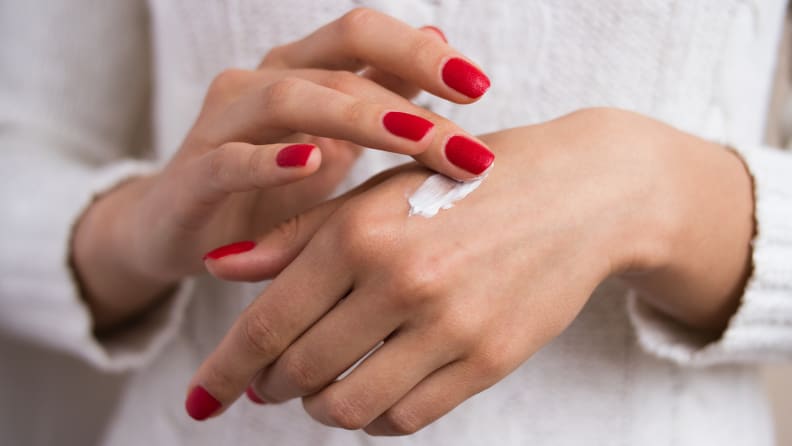
Don't forget that your hands need moisturizer, too.
Hydration should extend well beyond your face. Polla says to focus on your hands, which he calls the "second face" because they are exposed to the environment just as frequently. “Often, hands will become excessively dry and uncomfortable in cold weather, in particular as we age,” he says. The best ingredients to look for in a hand cream include glycerol or glycerin, urea, ceramides, hyaluronic acid, plant oils, and shea butter. After testing hand creams, our pick is the Kiehl’s Ultimate Strength Hand Salve because of its rich formula that moisturizes without leaving behind a greasy film.
8. Prioritize your sleep
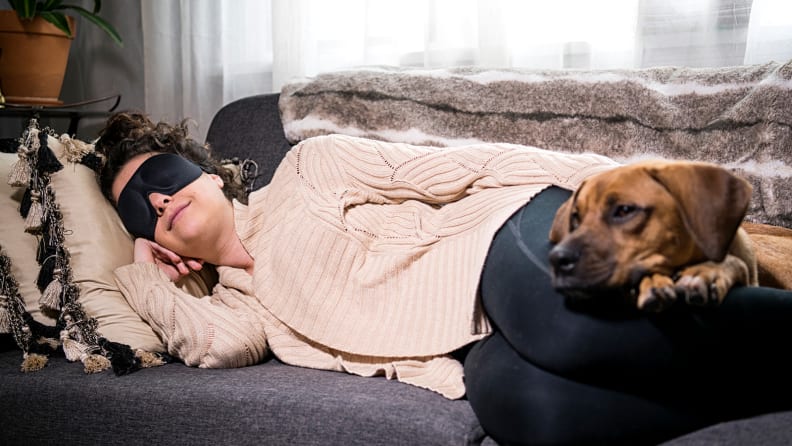
Wear a sleep mask to get a better snooze.
Another way to keep your winter skin glowing and radiant? Investing in and prioritizing your sleep. As Sarkar explains, chronic poor or low quality sleep is associated with increased signs of aging, a poor skin barrier function, and people feeling worse about how they look. “Being mindful about sleep hygiene, stress levels, and caffeine can help to normalize sleep patterns and help to ensure you get enough sleep every night,” says Sarkar. “Better quality sleep can mean more beautiful skin. That’s a win-win!”
For a better snooze, consider wearing a sleep mask, like Reviewed’s favorite Nidra Deep Rest, which is not only comfortable but excellent at blocking out light. Or, for a high-end feel with an affordable price, we also recommend the silk sleep mask from Alaska Bear.
The product experts at Reviewed have all your shopping needs covered. Follow Reviewed on Facebook, Twitter, Instagram, TikTok, or Flipboard for the latest deals, product reviews, and more.
Prices were accurate at the time this article was published but may change over time.



